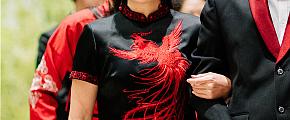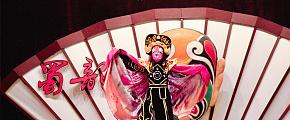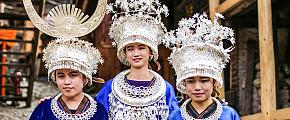Mystery of Chinese Royal Architecture
With vivid characteristics, Chinese royal buildings, especially the most popular tourist attractions in Beijing, are mysterious to today's people. Here we take the Forbidden City as an example and collect something interesting about this imperial palace. If you explore it without a guide, you will never know the secrets. Let's feel it more than just watch it!
The Ornamental Pillars (Hua Biao)
A pair of marble pillars decorated with exquisite clouds and entwined dragon carvings can be often found in front of most large royal complexes. They were originally made of wood and used to solicit public opinions from the people. They were also treated as landmarks or road signs. But later, they were only used to decorate important buildings.
The most famous Huabiaos are located at Tiananmen, two in front of the gate of Tiananmen and two behind the gate. On top of the Huabiaos, there sits a mythical animal called Hou. It is believed that the positioning of the Hous' heads was a reminder to the emperor of the hopes of the people. The two behind the gate looking at the palace (north) expecting the emperor to go out often and to understand the life of the people better. The two in front facing south express a longing for the emperor's return to run state affairs when he was absent from the palace for too long.
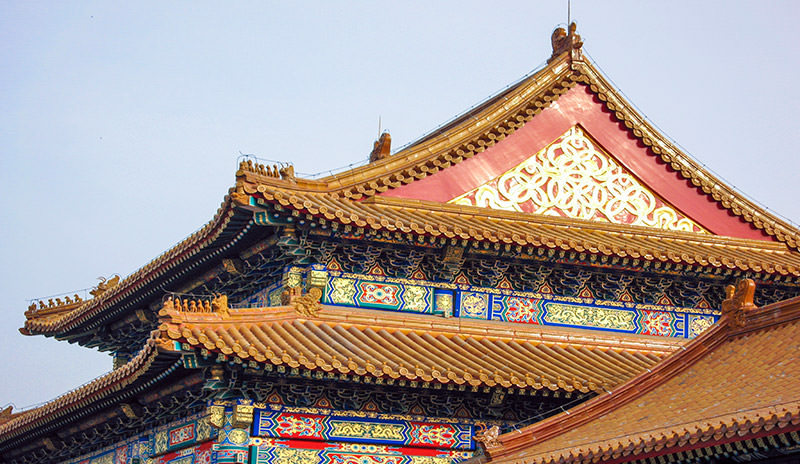 Mystery of Chinese Royal Architecture
Mystery of Chinese Royal Architecture
Stone/Bronze Lions
The lion is a special animal to Chinese people. A pair of stone or bronze lions, a male and a female, can often be seen in front of the gates of traditional buildings. The male lion is on the left with his right paw resting on a ball, and the female is on the right with her left paw fondling a cub.
Marble Terrace
Most of the Chinese ancient royal buildings stand on a marble terrace. The white marble terrace can not only support and magnify the single building on it but also protect the wood structure from dampness. It also has a deeper meaning. It reflects the rank of the building.
Grand Roof
Roofs are very important to Chinese architecture. Palaces had particularly impressive elaborate roofs. The distinctive roof of Chinese architecture involves a great deal of symbolism. Symbolism is present in the colors and tiers of the eaves, roofing materials, and rooftop decorations.
Yellow, regarded as an auspicious color, was exclusively used by the imperial families of the Ming and Qing Dynasties. Imperial roofs are certainly brilliant gold or imperial yellow.
Tunjishou (the ridge-devouring beast)
Watch carefully, you will find the ridges of each roof are topped with figures of mythical creatures. Fierce and formidable, it looks as if it were ready to devour the whole ridge, so it is also known as tundish or the ridge-devouring beast.
What were they used for? For decorative purposes only? According to architects, these strange-looking creatures can prevent the roof from sliding. Moreover, the number and the size of the creatures on the eaves indicate the importance of the building. When visiting the royal palace, it can be very interesting to count the animals on the eaves and get to know exactly how important the building was.
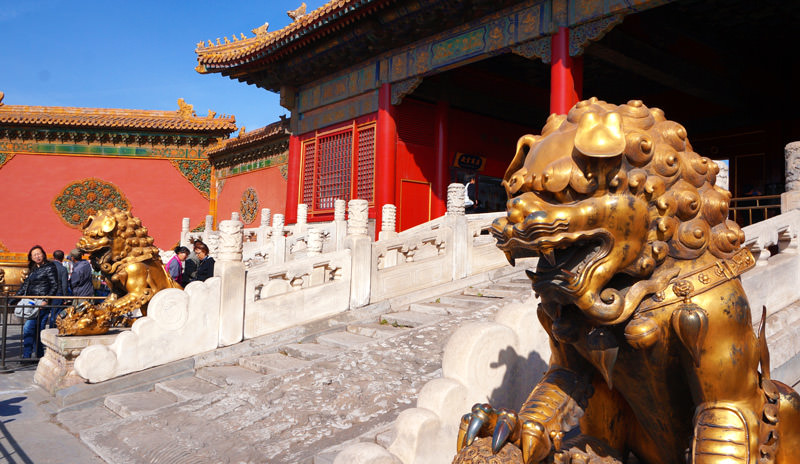 Mystery of Chinese Royal Architecture
Mystery of Chinese Royal Architecture
Taihe Dian
Now, it is very easy to figure out that the Hall of Taihe Dian is the main hall of the Forbidden City.
First, the building is raised on a triple marble terrace, 8 m (26 ft) high, enclosed by marble balustrades, whilst those around the same courtyard were kept lower so as to set off the magnificence of the hall.
Second, it has a roof with double eaves and is decorated with carved dragons and phoenixes, most of which are gilded.
Third, don't forget the little mythical creatures on the eave. There are 12 in total, most of all! The Hall of Taihe Dian was the place where emperors in the Ming and Qing dynasties held.
Colors in the Forbidden City
The Forbidden City is a complex painted in just two colors, yellow and red, which can be seen throughout the city. The color red signifies happiness, and yellow signifies earth. In ancient China, the color yellow, in particular, was most extensively and exclusively used by the emperors, who were regarded as the Sons of Heaven and the supreme rulers of humanity.
Therefore, yellow became the dominant color in the Forbidden City. Roofs are built with yellow glazed tiles; decorations in the palace are painted yellow; even the bricks on the ground are made yellow by a special process.
There is much more in the Forbidden City waiting for you to discover. Why are that no trees in the grand courtyard of the Hall of Taihe Dian.? Hundreds of gilt bronze vats are scattered in the Forbidden City. What were they used for? Only when you get there can you reveal its mysterious veil!
What are you waiting for? Discover yourself!
See the TOP10 China Tours or start tailor-making your own with us.
Related Posts You May Like
What Our Clients Say
"Great Customized Service", "Trip of A Lifetime", "Exceed All Expectations"

